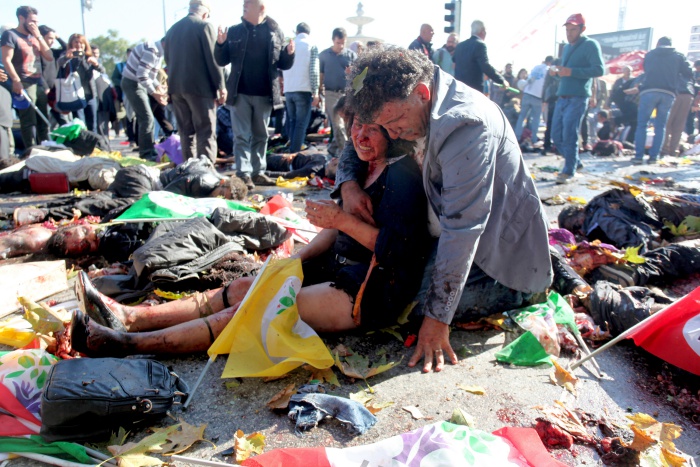Crucial evidence has emerged in the ongoing trial related to the 2015 Ankara bombings that killed 103 people and injured more than 500, revealing that a fugitive defendant was arrested and released a year before the attack despite video showing him in an execution performed by the Islamic State in Iraq and the Levant (ISIL), according to a special report by the T24 news website that dropped on Wednesday.
The bombings that took place on Oct. 10, 2015 at the Ankara train station were the deadliest Turkey has ever experienced. The two blasts took place near the city’s central terminal as people from mainly leftist and pro-Kurdish groups gathered to stage a demonstration demanding peace and an end to the ongoing conflict between the outlawed Kurdistan Workers’ Party (PKK) and the Turkish government.
Two explosions went off as people were congregating in the square.
About a year and a half prior to the massacre, police officers in Gaziantep stopped a vehicle in which Ahmet Güneş, one of the fugitive defendants in the Ankara bombing case, was a passenger. The officers discovered a hard disk, flash drive, memory card and a ski mask after materials were seen being thrown into bushes from the vehicle. A subsequent examination of the hard disk revealed footage of an ISIL execution in which both Güneş and Yunus Durmaz, another individual who later detonated himself during a police raid to his residence, were present.
Güneş was arrested in March 2014 on charges of membership in a terrorist organization and released in October 2014. The court’s release of Güneş came despite footage of his participation in an ISIL execution, and he allegedly participated in the Ankara bombings a year later.
This evidence was introduced to the Ankara bombings trial only seven years later after the bombings.
Güneş remained at large. He was later sentenced in absentia to six years, three months in prison for membership in a terrorist organization, reduced from an initial sentence of seven years, six months.
Lawyers representing the victims of the bombing point to a lack of action against identified individuals and public officials who failed to act on evidence. They also note frequent changes in the judicial panel, further prolonging the trial.
The next hearing is scheduled for Sept. 8, with lawyers inviting the public to attend as they continue to seek justice in the case marred by delayed evidence and procedural setbacks.
The Ankara bombings took place in the period between June and November 2015, historically the most critical timeframe of the Turkish Republic that saw a series of terrorist attacks.
Some of the previous remarks of Ahmet Davutoğlu, former Turkish prime minister who parted ways with the ruling Justice and Development Party (AKP) and established the Future Party (GP) a few years ago, were interpreted as suggesting that some ruling party politicians had prior knowledge of the attacks or deliberately failed to prevent them so that an environment of chaos would take hold in the country, the public would be frightened and the AKP, which had lost its majority in a general election in June of that year, would be returned to power.
According to observers, that summer diverted public concern from the economy and authoritarian rule to national security, ultimately increasing public support for the AKP in November.
Following the massacre in Ankara, which took place in one of Turkey’s darkest periods, no ministers or public officials were dismissed from the government.
A report drafted by the Interior Ministry had revealed on Feb. 25, 2016 that some public officials bore some responsibility for the incident. According to the report, which was leaked to the media, intelligence that ISIL might stage an attack on gatherings by leftist and Kurdish groups in Ankara and other cities had been conveyed to the police. Moreover, the names of the train station bombers had also been mentioned several times in these intelligence notices.

